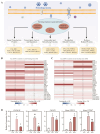Proteomic Insights into the Regulatory Mechanisms of the Freezing Response in the Alpine Subnivale Plant Chorispora bungeana
- PMID: 39769146
- PMCID: PMC11678613
- DOI: 10.3390/ijms252413381
Proteomic Insights into the Regulatory Mechanisms of the Freezing Response in the Alpine Subnivale Plant Chorispora bungeana
Abstract
Freezing temperatures impose significant constraints on plant growth and productivity. While cold tolerance mechanisms have been extensively studied in model species, the molecular basis of freezing tolerance in naturally adapted plants remains underexplored. Chorispora bungeana, an alpine plant with a strong freezing tolerance, provides a valuable model for investigating these adaptive mechanisms. In this study, we used Tandem Mass Tag (TMT)-based quantitative proteomics to analyze C. bungeana seedlings subjected to freezing stress (-6 °C) at 6 and 30 h, identifying 302 differentially expressed proteins (DEPs) compared with controls. Our findings capture the dynamic proteomic landscape of C. bungeana under freezing stress, revealing distinct early and prolonged responses. Early responses featured upregulated proteins involved in signaling and stress protection, with no clear involvement of the ICE1-CBF pathway (ICE1: Inducer of CBF Expression 1; CBF: C-repeat Binding Factor) found in cold-acclimating plants, while calcium signaling and epigenetic modifications enabled a rapid response. Extended exposure involved DEPs in RNA modification, glutamine metabolism, and biosynthesis of polysaccharides and flavonoids, highlighting metabolic adjustments crucial for long-term adaptation. By combining protein-protein interaction (PPI) networks and functional analysis, we identified 54 key proteins validated by qRT-PCR. These findings provide comprehensive insight into freezing tolerance mechanisms, identifying candidate proteins for enhancing cold resilience in crops and mitigating agricultural cold stress impacts.
Keywords: Chorispora bungeana; cold stress; differentially expressed proteins; freezing stress; proteomic analysis.
Conflict of interest statement
The authors declare no conflicts of interest.
Figures





Similar articles
-
Chilling- and Freezing-Induced Alterations in Cytosine Methylation and Its Association with the Cold Tolerance of an Alpine Subnival Plant, Chorispora bungeana.PLoS One. 2015 Aug 13;10(8):e0135485. doi: 10.1371/journal.pone.0135485. eCollection 2015. PLoS One. 2015. PMID: 26270551 Free PMC article.
-
Deep-sequencing transcriptome analysis of chilling tolerance mechanisms of a subnival alpine plant, Chorispora bungeana.BMC Plant Biol. 2012 Nov 21;12:222. doi: 10.1186/1471-2229-12-222. BMC Plant Biol. 2012. PMID: 23171377 Free PMC article.
-
Comparison with Arabidopsis reveals optimal nitrogen allocation strategy and mechanism in Chorispora bungeana, a cryophyte with strong freezing tolerance.J Plant Physiol. 2021 Jan;256:153311. doi: 10.1016/j.jplph.2020.153311. Epub 2020 Nov 13. J Plant Physiol. 2021. PMID: 33249387
-
Natural Variation in Freezing Tolerance and Cold Acclimation Response in Arabidopsis thaliana and Related Species.Adv Exp Med Biol. 2018;1081:81-98. doi: 10.1007/978-981-13-1244-1_5. Adv Exp Med Biol. 2018. PMID: 30288705 Review.
-
Molecular and Physiological Responses of Plants that Enhance Cold Tolerance.Int J Mol Sci. 2025 Jan 29;26(3):1157. doi: 10.3390/ijms26031157. Int J Mol Sci. 2025. PMID: 39940925 Free PMC article. Review.
References
-
- Rezaei E.E., Webber H., Asseng S., Boote K.J., Durand J.-L., Ewert F., Martre P., MacCarthy D.S. Climate change impacts on crop yields. Nat. Rev. Earth Environ. 2023;4:831–846. doi: 10.1038/s43017-023-00491-0. - DOI
MeSH terms
Substances
Grants and funding
LinkOut - more resources
Full Text Sources

